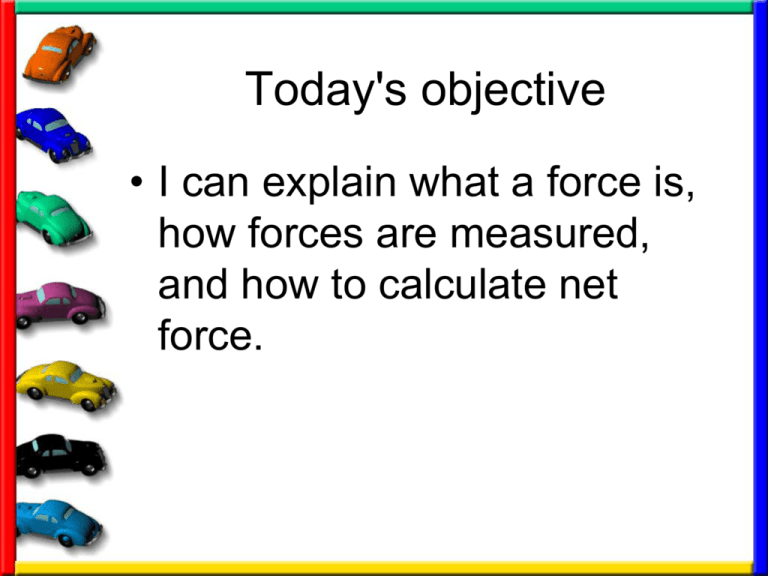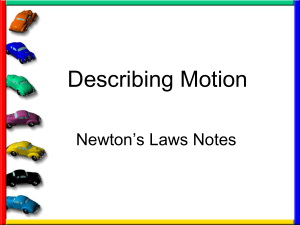net force
advertisement

Today's objective • I can explain what a force is, how forces are measured, and how to calculate net force. First we need to define the word FORCE: • The cause of motion (what causes objects to move) • Two types of forces – Pushes – Pulls Two things that every force must have… • Magnitude – how big (or small) is the force – A number in Newtons • Direction – which way is the force moving – Left, right, up, down Forces are measured in Newtons • SI unit of force • Symbol: N • Measured by using a spring scale Forces may be balanced or unbalanced • Balanced forces – all forces acting on an object are equal – There is NO MOTION – Combined forces equal ZERO • Unbalanced forces – one or more forces acting on an object are stronger than others – There is MOTION • A NET FORCE Balanced and Unbalanced Forces Net Force • The combination of all the forces acting on an object is the net force. Combining Forces in the Same Direction Combining Forces in Opposite Directions Learning Objective Today I will be able to investigate and describe application of Newton’s Laws of Motion. Newton’s Laws • First Law – Inertia • Second Law – Acceleration, Force & Mass • Third Law – Action-Reaction First Law • Inertia – An object at rest [not moving] remains at rest unless acted on by a force [push or pull] – An object in motion remains in motion unless acted on by a force [push or pull] First Law • Inertia & Mass – The more MASS an object has, the more INERTIA the object has. – INERTIA is an objects tendency to resist a change in motion – Bigger objects are harder to start & stop because of INERTIA Second Law • The ACCELERATION of an object is equal to the net force acting on the object divided by the object’s mass. • The direction of acceleration is the same as the direction of the net force. Second Law • Acceleration & Force – The more force placed on an object, the more it will accelerate [change its motion] • Acceleration & Mass – The more mass [or inertia] an object has, the more force it takes to accelerate the object Third Law • Action – Reaction – Forces are always produced in pairs with opposite directions & equal strengths – For every force there is an equal and opposite force Momentum • Momentum is a measure of how hard it is to stop a moving object. • Because action and reaction forces do not cancel each other, they can change the motion of objects. The truck is in motion. What is the force that causes it to stop? The push of the stopped car. The car is at rest. What is the force that causes it to move? The push of the truck. What about the ladder on top of the truck? The ladder is in motion because the truck is in motion. When the truck stops, the ladder stays in motion. NEWTONS LAW OF INERTIA (1ST) The truck is stopped by the force of the car, but the ladder is not. What force stops the ladder? Gravity. The truck is in motion, the car is at rest. How do each of these vehicles accelerate (change in velocity)? The truck stops moving. The car starts moving. Which one will be the hardest to accelerate? The truck because it has the most mass (INERTIA). Why does the car move [accelerate] when it is hit by the truck? The heavy and moving truck has more force than the small, at rest car. Why does the truck stop moving when it hits the car? The force of the car pushing back on the truck, plus the force of friction between the massive truck and the road slow down, that stop the truck. The truck hits the car. An action force stops the truck. What is the equal and opposite reaction force? The force car pushing back on the truck. According to Newton’s second law, when the reaction force results in an unbalanced force, there is a net force, and the object accelerates.



